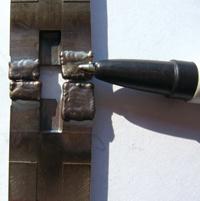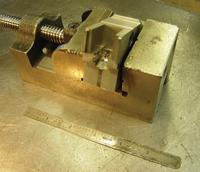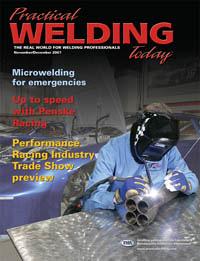- FMA
- The Fabricator
- FABTECH
- Canadian Metalworking
Categories
- Additive Manufacturing
- Aluminum Welding
- Arc Welding
- Assembly and Joining
- Automation and Robotics
- Bending and Forming
- Consumables
- Cutting and Weld Prep
- Electric Vehicles
- En Español
- Finishing
- Hydroforming
- Laser Cutting
- Laser Welding
- Machining
- Manufacturing Software
- Materials Handling
- Metals/Materials
- Oxyfuel Cutting
- Plasma Cutting
- Power Tools
- Punching and Other Holemaking
- Roll Forming
- Safety
- Sawing
- Shearing
- Shop Management
- Testing and Measuring
- Tube and Pipe Fabrication
- Tube and Pipe Production
- Waterjet Cutting
Industry Directory
Webcasts
Podcasts
FAB 40
Advertise
Subscribe
Account Login
Search
9-1-1: Weld Emergency!
Microwelding shop performs on-the-spot fixes
- By Amanda Carlson
- November 6, 2007
- Article
- Arc Welding

Looking through the microscope of the laser welding machine, Eric Hild adds metal to a part the size of a battery, which is held stationary by a magnetic positioner.
If ever there was an emergency room for molds and dies and other small parts, Toolweld Inc., Algonquin, Ill., is it. At least that's how Fred and Eric Hild, the father/son duo who own and operate the shop, feel. It's so much so that the shop comes complete with a waiting room but without the bad hospital cafeteria food. And much like an emergency room where each patient is different, each job that comes through the shop door is unique.
"There's no boredom. Every guy that comes in wants something different. Sometimes that's interesting, sometimes it's not. It depends on what they want, but you don't get bored,"Fred remarked.
The company doesn't work solely on molds and dies, but both men agree that this type of work comprises a majority of their business. Replacing worn-out molds or molds that are rendering flash can be expensive and time-consuming because of their detailed shapes and size specifications. Instead, companies bring the molds to the Hilds to be repaired. Eric and Fred add metal to edges or in hard-to-reach areas to set specifications. After the metal has been added, customers take their parts to be machined.
The shop houses two welding units—Fred mans the micro-GTAW machine while Eric runs the laser. The two don't like to pigeonhole themselves into welding one type of product, but a general rule they like to follow is that if you can't carry the part in, it's too big to be microwelded.
Mastering the World of Microwelding
Both men have crafted their respective skills mostly through trial and error. Both say that microwelding, in general, is a trade that is passed down from welder to welder and perfected through repetition. Eric, who learned the skill from his father, started out by laying beads on plate. It took him two years to get comfortable using the micro-GTAW machine. Fred, on the other hand, describes learning to view the welding process through a microscope as "trying to spear a fish, and missing."
"The more practice you get, you just start to memorize what you can and can't do. Does that mean you learn it all? I've been doing it for 25 years, and you'll never catch me saying that I've seen it all. You just have to figure it out. You have no choice, you have to figure out a way,"Fred said.
Because the welding at Toolweld is done on a job-by-job basis, there's no formula or one right way to approach things, and the Hilds have had plenty to figure out over the years. Walk-in customers toting worn-out parts point out where work needs to be done, pull up a chair and a magazine, and wait. Does that add to the pressure? Yes, but that's old news for both Hilds, who are used to working their way through problems and figuring out solutions on their own while the clock is ticking. Because the parts they work on are so expensive, so intricate in design, and are depended on so heavily by various production lines, there is no room for error. This means both Eric and Fred have to form a game plan before they attack the problem.
"When we get a piece in, the first thing we do is look at it and figure out what we could do to damage the part. The next step is to figure out how we're going to approach it, how we're going to get at it, and what we're going to do when we get there,"Fred said.
"These guys [the molders] usually run two or three shifts. So everything is,'I need it right now.'"
Learning Laser Lessons
Not all the work that comes through the doors is suitable for the micro-GTAW machine. Materials like copper and aluminum absorb heat, causing the heat that is needed at a specific area to travel to other areas where it can potentially damage strict tolerances. The laser welding machine addresses that problem, because contact between the beam and the workpiece occurs so quickly. Also, parts with deep cavities make micro-GTAW difficult. Fred's only choice is extending the tungsten, which is not recommended.
"The kind of stuff we work on is so tiny and so finicky, running two beads can actually bend it. With the lasers there's almost no heat, it's so instantaneous. It never really gets a chance to get hot. If you're welding with a regular GTAW torch, the heat is constant. Even if you're microwelding [using GTAW] and you're putting on a tiny bead, you've got constant heat, and it keeps getting hotter and hotter,"Fred added.
But they weren't sold on the laser right away. In fact, it took them a year of mulling it over and talking to customers before they decided to make the purchase. Many customers were unsure that the Hilds even needed a laser. The first concern was the expense associated with laser equipment. Other factors included wire feeding and workpiece positioning time. After a gradual drop in business, the Hilds decided to purchase a 120-W laser machine with a magnetic work positioner, movable bench, and a gas lens.
Is the laser the answer for all jobs? Not at all, said Eric. While the laser welding unit releases less heat, it can be time-consuming with all the repositioning that must take place to get the laser beam in the correct position. When attempting a weld, Eric may have to move the workpiece 10, 15, or 20 times to get it right. Also, the unit Eric uses does not have a wire feeder, meaning he holds the wire—which is sometimes no thicker than a human hair—directly under the laser beam. This, too, can be time-consuming.
But with practice came perfection. Eric said he had a lot to learn about using the laser the first few months, but now he finds that jobs that used to take him an entire day now take only half a day.
"Working with the laser the first year is a learning curve. Every month or two you get a little bit faster until you can't get any faster.
"It gets to be difficult when I've got to go into something. I learned for a year all these tricks of how to get in there, how to get it just right,"Eric said.
Despite the longer process time, customers in general like their products laser-welded because its precision results in less buildup to machine. While everyone needs their parts done right away, Eric said people are willing to wait for the laser weld.
Will the laser machine eventually take over all the responsibilities of the shop? Both Eric and Fred agree that it won't.
"The laser does some things really well and a lot of things not well. But the things it does really well, no other machine can do. The microwelder does a lot of things really well, but it can't do some things. You need both,"Fred said.
About the Author

Amanda Carlson
2135 Point Blvd
Elgin, IL 60123
815-227-8260
Amanda Carlson was named as the editor for The WELDER in January 2017. She is responsible for coordinating and writing or editing all of the magazine’s editorial content. Before joining The WELDER, Amanda was a news editor for two years, coordinating and editing all product and industry news items for several publications and thefabricator.com.
About the Publication
subscribe now

The Welder, formerly known as Practical Welding Today, is a showcase of the real people who make the products we use and work with every day. This magazine has served the welding community in North America well for more than 20 years.
start your free subscription- Stay connected from anywhere

Easily access valuable industry resources now with full access to the digital edition of The Fabricator.

Easily access valuable industry resources now with full access to the digital edition of The Welder.

Easily access valuable industry resources now with full access to the digital edition of The Tube and Pipe Journal.
- Podcasting
- Podcast:
- The Fabricator Podcast
- Published:
- 04/16/2024
- Running Time:
- 63:29
In this episode of The Fabricator Podcast, Caleb Chamberlain, co-founder and CEO of OSH Cut, discusses his company’s...
- Industry Events
16th Annual Safety Conference
- April 30 - May 1, 2024
- Elgin,
Pipe and Tube Conference
- May 21 - 22, 2024
- Omaha, NE
World-Class Roll Forming Workshop
- June 5 - 6, 2024
- Louisville, KY
Advanced Laser Application Workshop
- June 25 - 27, 2024
- Novi, MI

































